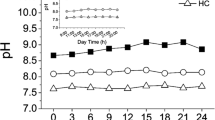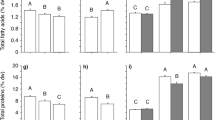Abstract
This work aimed to verify the effects of adding CO2 and irradiance to Kappaphycus alvarezii cultivation. Thalli were cultured in vitro for 2 weeks under low irradiance (50 μmol photons m−2 s−1) with the addition of CO2 according to the following concentrations: 142× 103 ppm (1CO2, 0.1 L min−1), 285 × 103 ppm (2CO2, 0.2 L min−1) and 428 × 103 ppm (3CO2, 0.3 L min−1), followed by culture under higher irradiance (200 μmol photons m−2 s−1) for 2 more weeks. Control had no CO2 addition. Afterwards, growth rate, chlorophyll a and carotenoid content were quantified. Samples were submitted to light microscopy and transmission electron microscopy. Growth rates of different treatments or control between experimental periods showed no significant differences, except for 2CO2 treatment at the end of each period. Kappaphycus alvarezii cultivated with CO2 addition showed cell wall thickening and increasing quantity of starch granules, chlorophyll a and carotenoids compared with control. Exposed to high irradiance, control samples showed signs of stress, such as changes in chloroplast, starch granules quantity decrease and total chlorophyll a and carotenoids increase. Samples cultivated with CO2 showed an increase in the quantity and size of the starch granules and an increase in the number of organelles (mitochondria) related to energy generation and cell construction (Golgi complex). Such alterations suggest cellular response after CO2 addition, such as the formation of starch reserves and cell wall thickening, which could make plants more tolerant to environmental stress during transport from indoor condition to sea farms.












Similar content being viewed by others
References
Andria J, Vergara J, Perez-Llorens JL (1999) Biochemical responses and photosynthetic performance of Gracilaria sp. (Rhodophyta) from Cádiz, Spain, cultured under different inorganic carbon and nitrogen levels. Eur J Phycol 34:497–504
Borlongan IAG, Gerung GS, Nishihara GN, Terada R (2017) Light and temperature effects on photosynthetic activity of Eucheuma denticulatum and Kappaphycus alvarezii (brown and green color morphotypes) from Sulawesi Utara, Indonesia. Phycol Res 65:69–79
Bouzon ZL (2006) Histoquímica e ultra-estrutura da ontogênese dos tetrasporângios de Hypnea musciformis (Wulfen) J. V. Lamour. (Gigartinales, Rhodophyta). Rev Bras Bot 29:229–238
Bréhélin C, Kessler F, Vanwijk (2007) Plastoglobules: versatile lipoprotein particles in plastids. Trends Plant Sci 12:260–266
Chung IK, Beardall J, Mehta S, Sahoo D, Stojkovic S (2010) Using marine macroalgae for carbon sequestration: a critical appraisal. J Appl Phycol 23:877–886
Edwards P (2000) Aquaculture. Poverty impacts and livelihoods. Natural Resource Perspectives, No. 56. Overseas Development Institute, London 4 pp
Edwards P, Demaine H, Innes-Taylor N, Turongruang D (1996) Sustainable aquaculture for small-scale farmers: need for a balanced model. Outlook Agric 25:19–26
FAO (2018) The state of world fisheries and aquaculture: meeting the sustainable development goals. Rome. Italy
Flores ALG (2014) Viabilidade do cultivo em tanques de macroalgas Kappaphycus alvarezii (Rhodophyta, gigartinales) para manutenção de matrizes. Dissertation, Universidade Federal de Santa Catarina, Florianópolis, Brazil
Fournet I, Zinoun M, Deslandes E, Diouris M, Floc'h JY (1999) Floridean starch and carrageenan contents as responses of the red alga Solieria chordalisto culture conditions. Eur J Phycol 34:125–130
Gahan PB (1984) Plant histochemistry and cytochemistry: an introduction, vol 18. Academic Press, Florida
Gao K, McKinley KR (1994) Use of macroalgae for marine biomass production and CO2 remediation: a review. J Appl Phycol 6:45–60
Gordon EM, McCandless EL (1973) Ultrastructure and histochemistry of Chondrus crispus stack. Proce Nova Scotia Inst Sci 27:111–133
Graham LE, Wilcox LW (2009) Algae. Prentice Hall, Upper Saddle River
Hayashi L, Hurtado AQ, Msuya FE, Bleicher-Lhonneur G, Critchley AT (2010) A review of Kappaphycus farming: prospects and constraints. In: Seckbach J, Einav R, Israel A (eds) Seaweeds and their role in globally changing environments. Cellular origin, life in extreme habitats and astrobiology. Springer, Dordrecht, pp 251–283
Hayashi L, Santos AA, Faria GSM, Nunes BG, Souza MS, Fonseca ALD, Barreto PLM, Oliveira EC, Bouzon ZL (2011a) Kappaphycus alvarezii (Rhodophyta, Areschougiaceae) cultivated in subtropical waters in Southern Brazil. J Appl Phycol 23:337–343
Hayashi L, Faria GSM, Nunes BG, Zitta CS, Scariot LA, Rover T, Felix MRL, Bouzon ZL (2011b) Effects of salinity on the growth rate, carrageenan yield, and cellular structure of Kappaphycus alvarezii (Rhodophyta, Gigartinales) cultured in vitro. J Appl Phycol 23:439–447
Holzinger A, Lütz C, Karsten U, Wiencke C (2004) The effect of ultraviolet radiation on ultrastructure and photosynthesis in the red macroalgae Palmaria palmata and Odonthalia dentata from Arctic waters. Plant Biol 6:568–577
Indriatmoko H, Limantara L, Brotosudarmo THP (2015) Composition of photosynthetic pigments in a red alga Kappaphycus alvarezii cultivated in different depths. Procedia Chem 14:193–201
Iskandar A, Syam R, Trijuno DD (2014) Content of carrageenan, chlorophyll a and carotenoid of Kappaphycus alvarezii cultivated in different seawater depth Laikang Village, District of Mangarabombang, Takalar Regency. JAB 2:1–9
Israel A, Gavrieli J, Glazer A, Friedlander M (2009) Utilization of flue gas from a power plant for tank cultivation of the red seaweed Gracilaria cornea. Aquaculture 249:311–316
Ji Y, Xu Z, Zou D, Gao K (2016) Ecophysiological responses of marine macroalgae to climate change factors. J Appl Phycol 28:2953–2967
Korbee N, Navarro NP, García-Sánchez M, Celis-Plá PSM, Quintano E, Copertino MS, Pedersen A, Mariath R, Mangaiyarkarasi N, Pérez-Ruzafa Á, Figueroa FL, Martínez B (2014) A novel in situ system to evaluate the effect of high CO2 on photosynthesis and biochemistry of seaweeds. Aquat Biol 22:245–259
Little DC, Barman BK, Belton B, Beveridge MC, Bush SJ, Dabaddle L, Demaine H, Edwards P, Haque MM, Kibria G, Morales E, Murray FJ, Leschen WA, Nandeesha MC, Sukadi F (2012) Alleviating poverty through aquaculture: progress, opportunities and improvements. In: Subasinghe RR, Arthur JR, Bartley DM, De Silva SS, Halwart M, Hishamunda N, Mohan CV, Sorgeloos P (ed) Farming the waters for people and food: proceedings of the Global Conference on Aquaculture 2010, Phuket. September 22–25, 2010, ed., 719–783. FAO and NACA, Rome/Bangkok
McCully M (1968) Histological studies on the genus Fucus. Protoplasma. 62:20–40
Muraoka D (2004) Seaweed resources as a source of carbon fixation. Bull Jap Fish Res Edu Agency 1:59–63
Nunes BG (2010) Monitoramento do ambiente do cultivo experimental da alga Kappaphycus alvarezii na praia de Sambaqui, Florianópolis/SC. Dissertation. Universidade Federal de Santa Catarina, Florianópolis, Brazil
Parry MAJ (2003) Manipulation of Rubisco: the amount, activity, function and regulation. J Exp Bot 54:1321–1333
Pedra AGLM, Ramlov F, Maraschin M, Hayashi L (2017) Cultivation of the red seaweed Kappaphycus alvarezii with effluents from shrimp cultivation and brown seaweed extract: effects on growth and secondary metabolism. Aquaculture 479:297–303
Pires CM (2017) Aproveitamento do efluente da carcinicultura de Litopenaeus vannamei em sistema biofloco pela macroalga Kappaphycus alvarezii. Dissertation Universidade Federal de Santa Catarina, Florianópolis, Brazil
Poppe P, Schmidt RAM, Hanelt D, Wiencke C (2003) Effects of UV radiation on the ultrastructure of several red algae. Phycol Res 51:11–19
Pueschel CM (1979) Ultrastructure of tetrasporogenesis in Palmaria palmata (Rhodophyta). J Phycol 15:409–424
Tee MZ, Yong YS, Rodrigues KF, Yong WTL (2015) Growth rate analysis and protein identification of Kappaphycus alvarezii (Rhodophyta, Gigartinales) under pH induced stress culture. Aquacult Rep 2:112–116
Terada R, Vo TD, Nishihara GN, Shioya K, Shimada S, Kawaguchi S (2015) The effect of irradiance and temperature on the photosynthesis and growth of a cultivated red alga Kappaphycus alvarezii (Solieriaceae) from Vietnam, based on in situ and in vitro measurements. J Appl Phycol 28:457–467
Tsekos I, Orologas N, Dimopoulou A (2007) Effects of brefeldin A on the structure and function of the Golgi apparatus in the marine red alga Erythrocladia subintegra Rosenvinge. J Biol Res 7:29–39
Usuldin SRA, Al-Obaidi JR, Razali N, Junit SM, Ajang MJ, Hussin SNIS, Hamid SS, Hanafi NM, Roni ANHM, Saleh NM (2017) Molecular investigation of carrageenan production in Kappaphycus alvarezii in different culture conditions: a proteomic approach. J Appl Phycol 29:1989–2001
Von Stosch HA (1963) Wirkung von Jod und Arsenit auf Meeresalgen in Kultur. Proc. Int. Seaweed Symp. 4:142-150.
Vreelan V, Kloareg B (2000) Cell wall biology in red algae: divide and conquer. J Phycol 36:793–797
Wakibia JG, Bolton JJ, Keats DW, Raitt LM (2006) Seasonal changes in carrageenan yield and gel properties in three commercial eucheumoids grown in southern Kenya. Bot Mar 49:208–215
Wellburn AR (1994) The spectral determination of chlorophylls a and b, as well as total carotenoids, using various solvents with spectrophotometers of different resolution. J Plant Physiol 144:307–313
Wu H, Jiang H, Liu C, Deng Y (2015) Growth, pigment composition, chlorophyll fluorescence and antioxidant defenses in the red alga Gracilaria lemaneiformis (Gracilariales, Rhodophyta) under light stress. S Afr J Bot 100:27–32
Yildiz G, Dere Ş (2015) The effects of elevated-CO2 on physiological performance of Bryopsis plumosa. Acta Oceanol Sin 34:125–129
Yong YS, Yong WTL, Anton A (2013) Analysis of formulae for determination of seaweed growth rate. J Appl Phycol 25:1831–1834
Zou D, Gao K (2009) Effects of elevated CO2 on the red seaweed Gracilaria lemaneiformis (Gigartinales, Rhodophyta) grown at different irradiance levels. Phycologia 48:510–517
Acknowledgements
LH thanks Conselho Nacional de Desenvolvimento Científico e Tecnológico (CNPq) for the Productivity Fellowship (Process number 308631/2017-0). We also thank Fernando Zwierzikowski da Silva for the technical support.
Funding
This study was financed in part by the Coordenação de Aperfeiçoamento de Pessoal de Nível Superior – Brasil (CAPES) – Finance Code 001.
Author information
Authors and Affiliations
Corresponding author
Additional information
Publisher’s note
Springer Nature remains neutral with regard to jurisdictional claims in published maps and institutional affiliations.
Rights and permissions
About this article
Cite this article
Ventura, T.F.B., Bruzinga, C.P., dos Santos, A.A. et al. Addition of carbon dioxide, followed by irradiance increase, as optimization strategy for the cultivation of the red seaweed Kappaphycus alvarezii. J Appl Phycol 32, 4113–4126 (2020). https://doi.org/10.1007/s10811-020-02210-4
Received:
Revised:
Accepted:
Published:
Issue Date:
DOI: https://doi.org/10.1007/s10811-020-02210-4




